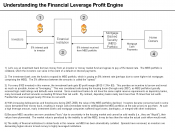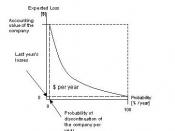The principles of risk and return:
Fundamentally, the greater the return the greater the risk; in other words there is a direct relationship between risk and return. An investor acting in rational self interest would only invest in a speculative investment if the investor is compensated by a greater return. For instance, gambling has the greatest risk attached, and also it potentially has the greatest return. However, government bonds have little to nil risk - in OECD country - but it also has the least return. In terms of securities low capital shares or speculative shares are risk orientated. This risk is due to the shares only needing to shift small amounts in worth to create large percentage gains or losses. Blue chip shares are renowned for being risk adverse thus profits are reduced.
When the fundamental theory of return and risk is applied to the three investors given different amounts of risk are taken.
Cathy who is young, reasonably affluent and has minimal liabilities could be defined as a High-Roller. High-rollers are people who believe money means infinite possibilities. Thrill seekers who enjoy financial risk but are only mildly interested in where it takes then. Money brings instant power and recognition.
Fred who is young, below average wage and has family and mortgage could be defined as a Money Master. Money Master is a person who balances their finances with the degree of contentment and security they derive from their money. Leading wealth accumulators even though they don't necessarily earn the most.
Jim and Joan who are nearing retirement, average wage and has house as liabilities could be defined as Safety Players. Safety Players are people who are the lowest in self determination. Average earners. Most of their money goes into safe and secure investments.
Aims of Investment:
Essentially, there are three main principles in investment:
Maximise income on the asset through interest, rents and dividends.
Capital gain due to assets value increasing.
Minimise risk through diversification of portfolio.
These principles of investment are generally correct, nonetheless due to the principle of risk and return strategies of investment will vary. Cathy being a profile of a High-Roller could invest now to accumulate immense wealth in years to come. Cathy is by fair in the best position due to her profile of being young, reasonably affluent and at this time has minimal liabilities. Fred would be selecting a strategy for investment that would be looking to the future. Fred has the greatest ingredient for affluence on his side and that is plenty of time. Fred's strategy should incorporate the costs education for his children and retirement. Jim and Joan's strategy for investment will be for the sole purpose of retirement with a golden nest egg (affluence). The best way for Jim and Joan to obtain the golden nest egg is thorough investing in shares with dividends to give them a sustainable and reasonably secure return. Aims of investment differentiate due to many different factors as these three investors made evident.
Considerations for setting up a portfolio:
When drafting a potential portfolio, there are numerous factors which need to be taken into account. If these particulars are neglected it could cause much economic strife for the investor. The categories of these factors are as follows:
Age - The utmost important consideration in a portfolio, it has been echoed by many economists as the essence of success. The younger the investors the more time they have to accumulate wealth or regain wealth. If applied to our investors, Cathy at age 25 is in the best position because not only dose she have a vast timeframe to invest, her health is also related to age. The next to benefit from being reasonably young would be Fred at age 33 again he has a long period of time to be able to invest in and his health would be related to his age. Jim and Joan are in the worst predicament only working for another 7 years which gives them a reasonably brief investing period. This would lead Jim and Joan to be more risk adverse.
Income - This area is important to analyse due to the potential to raise capital. Income includes savings by the individual as well. If the individual is highly paid they may receive more disposable income thus they can afford to invest more. Fred has a wage of $42,000 per year, but unfortunately he has nil savings, due to him directing all disposable income into his mortgage. I would advise Fred to pay off his mortgage with the inheritance, but due to his request I will be investing it in the stock market. Cathy's wage is $60,000 per year, which is a substantial amount for an individual who has no dependants. Thus, Cathy would have a greater amount of surplus income to be able to invest. Jim and Joan compound has a wage of $50,000 per year, this is a reasonable amount considering they have no other dependants. Therefore, they should be able to save a large amount of money to be able to use for investment.
Assets and Liabilities - This are is important to target if you are cunning because it can make and save money. If an investor has something with large capital (house, apartment, factory and so forth) they can use the equity in it to gear an investment. If an individual has liabilities they may be able to apply for tax concessions or even reduce the cost of the liability (interest). Fred owns a small amount of equity in his house due to paying off the loan and price increases, but since the house is his only safeguard I would not use the equity to gear any investments. Cathy can only be assumed to have a HECS loan. I would suspect that she has only rented a unit or dorm because she has just come out of university. Jim and Joan have not provided enough information but assuming they have a home I believe using the equity to gear a safe investment would be wise.
Dependants - This factor often works as a restraint for investors, this is due to the dependants needing financial support. Since the dependants rely on the investors income it substantially reduces the risk the individual may can take. Fred has an unemployed house wife and two children which all require his income to survive. These dependants will substantially reduce the amount of risk Fred can take with his own income, but due to them not needing the liquidity in the inheritance he can invest it with aggression. Cathy who is her only dependant can take all the risk she likes (even declare bankruptcy) because she is employed and unless she loses her job that's all she needs to live. Jim and Joan's dependants are each other, this is because their children have left home, however they cannot take great risks because of their age and possible loss of assets.
Variety of shares available:
It was quoted by a famous economist "There is a share for anyone." I believe he was alluding to the fact that there is a great variety of shares available, with varying risks and returns.
There are three different types of shares they are as follows:
Ordinary Shares: These are the most common and in Australia are the most often traded on the ASX. These shares have last preference to assets, profits and dividends after preference shares and debentures. Ordinary shares can often sometimes be given as a reward to share holders (really to gain more capital) for free or at a discounted rate, this is called a bonus offer. The main advantage these shares have compared to other forms of shares, is voting rights in the company. Ordinary shares can be broken down into a further three groups on the ASX. These groups are High capitals (blue chips), Mid Capitals (Green Chips) and Low Capitals (speculative). Blue Chips are shares are often international corporations with huge amounts of tangible assets. Blue Chips usually have consistent but slow capital growth and pay dividends. To be rough at defining blue chip shares, they are all the companies in the ASX S&P 100. In realty much more subtlety is used to evaluate blue chip companies. This subtlety includes checking credit ratings, portfolio diversification, accounting practices, multinational, audit disclosure, environmentally sound practices and profit surpluses. Green Chips are companies that are based in Australia and are reasonably safe to be invested in. The have a reasonably large amount of tangible assets and usually make greater profits and loses. Finally, speculative shares which are small companies sometimes with few tangible assets often patents, mine sites which artificially inflate prices. They are closely linked to the information technology, mining, telecommunications and energy indices. These companies are often seen to be volatile, ane are personally my favourite.
Preference Shares: These from of shares are less common and as the title suggests they have first preference on assets should the company fail. They do not have voting rights on company decisions.
Derivatives of shares: This by far is the most volatile market. Derivatives come from buying or selling the change in value of an ordinary share. This can be broken down into three group's futures, options and put options. The reason why these shares are so volatile is due only buying the change in value of the share, (sometimes a fraction of a cent) small shifts in the value can result in large percentage shifts.
I would advise all of the thee investors to buy into ordinary shares this is due to preference shares being uncommon and derivatives often needing to be traded in such large blocks (minimum of $20,000).
Alternative Investment Forms:
There are many ways to invest some of these include Capital ventures, property, debentures, bonds, gems, antiques, minerals, metals, oil, exchange rates, vintage cars, artworks, stamps and basically anything that can pay an income or increase in capital.
The most common investment boom recently in Australia is in property. This is partly due to the limited amount of land in desirable land in comparison to people who want to obtain the desirable land, thus the price is inflated by demand (demand pull inflation). I would advise all three investors to stay away from many of the obscure investments and stick to main stream ones which are regulated by government bodies such as ASIC. I would also advise them to be careful moving into some areas of the overheated property market at present unless the have considerable knowledge in this area.



Excellent
Thank you for a really good discussion of various investments and how they may be appropriate to different groups of investors. Investing wisely is absolutely important especially in achieving a secure retirement. What you've written provides vital information even for people who are intimidated by financial planning. Your use of headings and captions made your report easier to read. Your paper was well organized and skillfully presented. Excellent job!
9 out of 9 people found this comment useful.